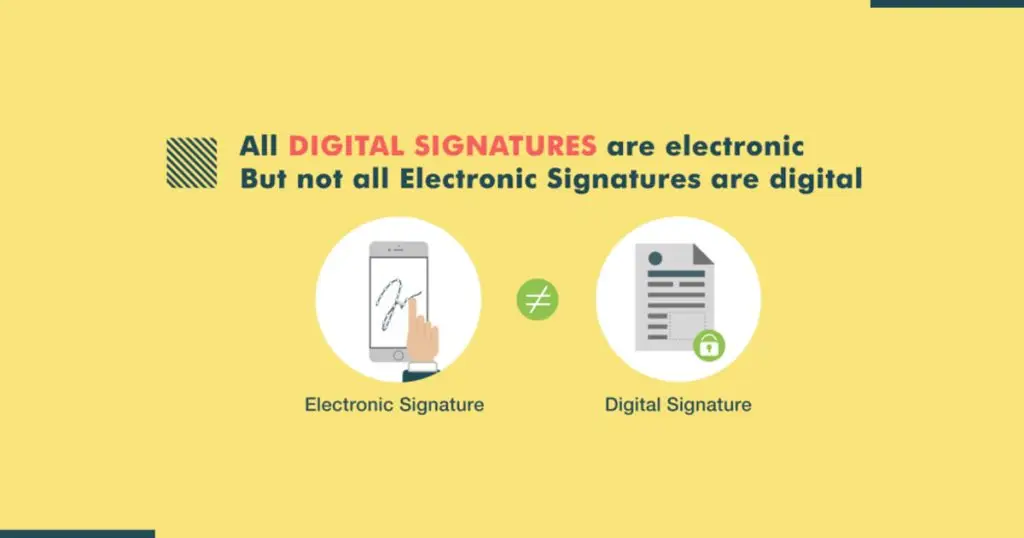Electronic Signature vs Digital Signature – WeSignature

Digital signature vs electronic signature: Do you use a digital signature when you sign a document online?
Is it possible to have an electronic one?
Is there a difference at all?
There is, indeed.
A very common question that gets asked while discussing the topic of electronic signatures is; What is the difference between digital signature vs electronic signature?
While often used interchangeably, electronic signatures and digital signatures are distinct concepts.
Digital signatures secure documents by ensuring authenticity, while electronic signatures indicate clear intent to sign contracts online.

Supplement Your Remote Working and Go Paperless With E-Signature Adoption
WeSignature is an electronic signature service for small businesses that enables quick, productive, cost-effective, and legally compliant document signing process. Adopt this solution today and transform your business completely.
However, the average signer isn’t always aware of this, and many people confuse the two terms.
We’ll go over the difference between digital and electronic signature so you’ll know what to look for if you’re thinking about switching to a paperless, digital platform.
What is Electronic Signature?
Electronic signatures are like an electronic process, or a symbol attached or logically associated with a contract or any other document. E-signatures are executed to perform online document signing by a person who has a clear intent to sign the document for different purposes.
In other words, an e-signature is more like a digital version of a handwritten signature. They are used to showcase the intent to either approve or accept the contents of important documents by either a person or different parties involved.
One of the most relevant and significant benefits of electronic signatures is that they make signing online documents remarkably simple. They enable the users to create an electronic signature in word with either a tap or just a click of the mouse allowing them to sign using their fingers or a stylus.
What is Digital Signature?
Digital signatures are one of the categories of electronic signatures that leverage algorithms to produce a unique digital fingerprint for each document. This digital fingerprint is linked to the signer’s identity and is used to authenticate it.
Fundamentally, one can create digital signatures utilizing the public key infrastructure system. The signature software uses an algorithm to produce two keys (a public and a private key) consisting of a sequence of numbers that are essentially linked to each other mathematically.
When any user signs an online document, he/she uses the private key to create a suitable signature. The private key is basically used to stay under the owner’s control essentially. At the time of the signing process, a crypto code ID is created and embedded inside the document.
When verification is facilitated, the signer simply utilizes his/her public key for unwrapping the digital signature code while subsequently comparing it with the document to ensure that there is a match.
A digital signature uses cryptography to provide authentic proof of the integrity and origin of every signature while verifying it.
What is a Digital Certificate?
Public Key Infrastructure (PKI) and the use of public and private keys are the foundation of digital signatures, which assure the safety of digital transactions. You need to know that all parties involved in an electronic signature transaction are utilizing valid keys.
At this point, the digital certificate becomes useful. An electronic document called a digital certificate is issued by a Certificate Authority (CA) or Trust Service Provider (TSP) to authenticate a signer’s identity and associate the signer’s public key with their name. Best-in-class eSignature systems integrate digital certificates in the e-sign process to authenticate the signer because the legal definition of an electronic signature always contains language around signer ownership.
Since the certificate contains data about the signer’s identity, it is used to verify and attest that a certain electronic signature belongs to a particular individual (e.g., name, ID number, signature keys, certificate issuer, etc.). In order to create a digital signature, certificates are frequently saved on the devices used to make those signatures, such as secure smart cards, tokens, and a hardware security module (HSM) in the cloud. The signer’s certificate is cryptographically linked to the document using the signer’s private key during the signing process.
Types of Digital Certificates
Organisational needs for digital certificates and how they are managed might vary widely depending on factors including location, industry, and the level of risk associated with a given transaction. It’s important to note that the location of the certificates is independent of the method chosen for signing.
Server-Signing Certificate: Digital signatures are stored in the cloud, where a trusted certificate is used to verify the signer’s identity and the authenticity of the document.
Local-Signing Certificate: It is the signer’s personal certificate stored locally on a PIN-protected smart card, USB token, or computer that verifies the signer’s identity and is used to digitally sign the document.
Key Differences Between Digital Signatures Vs Electronic Signatures
Electronic Signature
- Electronic signatures online are mainly used to verify the documents.
- An electronic signature is not regulated by the certification authorities.
- eSign uses a wide range of methods for the purpose of authenticating the signer’s identity such as enterprise ID, emails, phone verification, etc.
- Electronic signatures use an audit trail to showcase the proof of signing a document.
- eSign is concerned with a comparatively lesser number of security features when compared to digital signatures.
Digital Signature
- Digital signatures are mainly used to secure a document.
- On the other hand, digital signatures are most commonly regulated by certification authorities.
- Digital signatures use the certificate-based ID for the purpose of authenticating the signer’s identity.
- Digital signatures bind each signature to the document through encryption to showcase the proof of signing.
- Digital signatures are specifically concerned with an increasing number of security features.
The Main Differences Between Digital Signature and Electronic Signature
- The main difference is that a digital signature involves cryptographic methods, while an electronic signature is legally defined, giving it regulatory validity.
- Another distinction is the context in which they are employed. An electronic signature is mostly used to sign electronic documents where the signatory intends to use his e-signature to sign the document. A digital signature, on the other hand, is used to safeguard papers and is utilized by certification bodies.
- Electronic signatures serve as proof that the signee has accepted the conditions of a contract via electronic means. This includes typing their name into an email, entering a PIN at an ATM, electronically signing on a touch screen device, or checking a box for a streaming subscription.
- The basic goal of digital signatures is to secure a document so that it cannot be altered without permission. An electronic signature, on the other hand, is primarily used to verify a document.
- The verification process of the digital signature is performed by a trusted service provider or a trusted certification authority. There is no verification process for creating online signatures.
Conclusion – Difference Between Digital Signature and Electronic Signature
Digital signatures and electronic signatures are primarily used to sign documents online. When comparing the two, it is possible to conclude that electronic signatures are superior to digital signatures.
Now that the distinguish between digital vs electronic signature is pretty clear, it will get much easier to make an informed decision about the type of best esignature service for small business that will be perfectly suited for your business.
Because the best electronic signature software is more secure and requires less verification, this is the case. They use coded messages to link a document to the signer in a safe and secure manner.
Platforms like WeSignature enhance document security by generating encryption authentications and keys, such as usernames and logins. Because they provide the highest level of security, electronic signatures are widely accepted.
FAQ – Digital vs Electronic Signature
1. Does the Law Accept Digital Signature and Electronic Signature?
Both digital signature and electronic signature are legally binding where U.S. federal rule applicable, according to the federal ESIGN Act. In many cases where ESIGN fails to apply, UETA is a suitable alternative. The Uniform Electronic Transaction Act (UETA) was first introduced in 1999 and has essentially the same terms as ESIGN.
When both parties agree to move forward with a document signed electronically, the electronic signature is legally equivalent to a handwritten signature under both acts. UETA rules were adopted by Washington, D.C., the U.S. Virgin Islands and 47 states. Both ESIGN and UETA are electronic signature laws which is governed by US.
2. Do Electronic Signature and Digital Signature use Cryptographic Algorithms?
If we compare digital signature versus electronic signature, both have a lot of differences.
A digital signature has been created under cryptographic algorithms whereas electronic signatures are less secure. Cryptographic algorithms are not used in electronic signature.
3. When to Use a Digital vs Electronic Signature?
In many situations, a basic electronic signature is acceptable if you have been sent a document in PDF or Word format for signing. Talk to an expert if you’re unsure about the type of signature that’s needed.
Consider the document’s significance and potential legal objections before choosing between electronic and digital signatures. Some industries and countries require digital signatures for specific documents, while others require wet ink signatures or notarization.
4. What is the Difference Between an Advanced Electronic Signature and a Digital Signature?
Advanced electronic signatures (AES) and digital signatures are two types of electronic signatures used to sign documents and transactions electronically. AES is a secure and trustworthy electronic signature type that meets specific legal requirements set by eIDAS, the EU regulation on electronic identification and trust services.
Digital signatures use mathematical algorithms to create a unique fingerprint of signed data, ensuring high integrity and authenticity. Both electronic signature types provide secure and convenient alternatives to physical signatures, essential in modern business and legal practices.
5. Are Electronic Signature and Digital Signatures Better?
The choice between electronic and digital signatures depends on the specific needs and requirements of the user. Advanced electronic signatures (AES) under eIDAS meet legal requirements for higher security and trustworthiness than other electronic signatures.
Digital signatures use mathematical algorithms to create a unique fingerprint of signed data, ensuring high integrity and authenticity. The choice depends on factors like security needs, legal recognition, technical capabilities of the signing system, and user preferences.
Ultimately, both electronic and digital signatures provide a secure and convenient alternative to physical signatures.
6. Which is More Secure Between an Electronic Signature vs Digital Signature?
When it comes to security, digital signatures are generally considered to be more secure than electronic signatures.
Digital signatures create a unique digital fingerprint of signed data using cryptographic algorithms, encrypting it with a private key. This ensures that the signed data’s integrity and authenticity cannot be tampered with or altered without invalidating the signature.
The use of encryption and public key infrastructure (PKI) provides a high level of security and protection against fraud and forgery.
In contrast, electronic signature can include a range of different technologies and processes that do not necessarily provide the same level of security as digital signatures.
Advanced electronic signatures (AES) under eIDAS meet specific legal requirements but may not use the same encryption and PKI as digital signatures.
Overall, while both electronic signatures and digital signatures provide a secure way to sign documents on iPhone, Android devices and transactions electronically, digital signatures are generally considered to be more secure due to their use of encryption and PKI.
